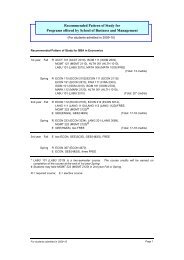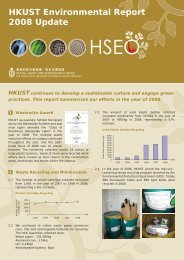What is Radiation? - Ab.ust.hk
What is Radiation? - Ab.ust.hk
What is Radiation? - Ab.ust.hk
Create successful ePaper yourself
Turn your PDF publications into a flip-book with our unique Google optimized e-Paper software.
Ultraviolet <strong>Radiation</strong> (UV)<br />
The bands:<br />
- UV-A: 400 – 315 nm (near UV)<br />
- UV-B: 280 – 315 nm (far UV)<br />
- UV-C: 100 – 280 nm (vacuum UV)<br />
• The wavelength of 260 – 280 nm UV light <strong>is</strong><br />
generally considered the most hazardous to the<br />
eyes.<br />
Biological Effect to UV<br />
• Effects on skin<br />
- Acute effects (急性效應)<br />
o Erythema (reddening skin) (紅斑) <strong>is</strong> a photochemical<br />
response of the skin. (UV-B and UV-C).<br />
- Chronic effects (慢性效應)<br />
o Accelerate skin aging (UV-B)<br />
o Develop skin cancer (UV-B and UV-A) strongly<br />
correlated with latitude, altitude and cloud cover.<br />
o Vitamin D synthes<strong>is</strong>.<br />
UV <strong>Radiation</strong> Hazard<br />
• High intensity of UV can generate ozone in air.<br />
(usually at UV-B and UV-C).<br />
• Ozone <strong>is</strong> a irritation gas.<br />
• Adverse effect to lung function when receive<br />
large dose of ozone gas.<br />
• Photo-chemical smog formation to cause air<br />
pollution in urban city.<br />
Smog formation = NO x + Ozone + hydrocarbon<br />
Solar UV<br />
• The solar UV <strong>is</strong> greatly attenuated by the<br />
earth’s ozone layer(臭氧層), limiting<br />
terrestrial UV to wavelength up to 290 nm.<br />
• Component of solar UV reaches earth’s<br />
surface:<br />
• 5 - 10% of UV-C;<br />
• 50 - 60% of UV-B;<br />
• 80 – 90% of UV-A.<br />
Biological Effects to UV<br />
• Effect on the eyes<br />
- Acute effects<br />
o Photokeratit<strong>is</strong> (光化性角膜炎)(snowblindness)<br />
commonly referred to as welder’s flash / arc-eye.<br />
o Painful last from 6 to 24 hours, d<strong>is</strong>appear within 48<br />
hours.<br />
- Chronic effects<br />
o Protein deposit or growth in the cornea.<br />
o Cataracts (白內障)<br />
o Conjunctiva (結膜炎)<br />
Protective Measures<br />
• Depending upon whether the UV radiation<br />
exposure occurs indoors or outdoors.<br />
• Outdoor: the use of hats, eye protectors, facial<br />
shields and clothing are practical.<br />
• Indoor: engineering control measures are<br />
preferable.

















